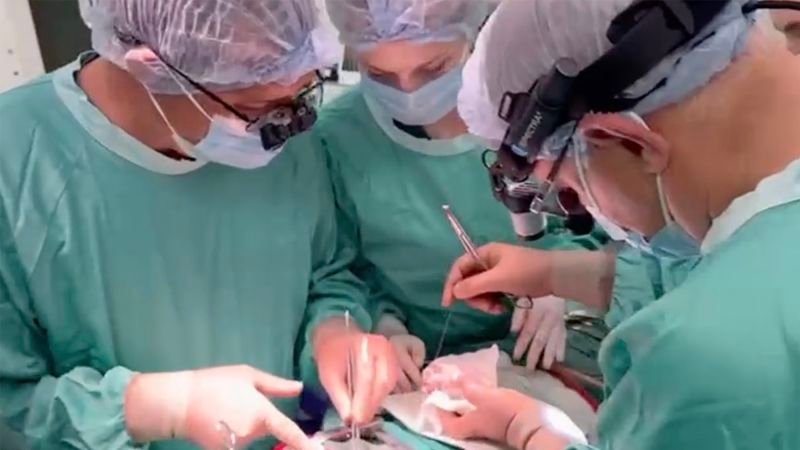Editor’s note: Sign up for Unlocking the World, CNN Travel’s weekly newsletter. Get news about destinations, plus the latest in aviation, food and drink, and where to stay.
CNN
—
The shutdown of London’s Heathrow Airport, one of the busiest airports in the world, is causing chaos across the world today, with thousands of flights affected and major disruption expected to last for days.
At least 1,351 flights so far have been impacted by Friday’s closure, which is due to a “significant power outage” caused by a large fire nearby. Some experts predict that it will take several days for the airport to resume full operation and to clear flight backlogs.
A spokesperson for Heathrow, which flies up to 291,000 passengers a day, has since announced that the west London airport will be resuming some flights later today and “hope to run a full operation tomorrow.”
“Our teams have worked tirelessly since the incident to ensure a speedy recovery,” reads a statement from Heathrow.
“We’re pleased to say we’re now safely able to begin some flights later today. Our first flights will be repatriation flights and relocating aircraft.”
“Passengers are advised not to travel to the airport and should contact their airline for further information. We apologize for the inconvenience.”
According to live flight-tracking website Flightradar24, at least 120 aircraft were en route to the airport, which connects London with over 230 destinations in nearly 90 countries, when the unexpected closure was announced.
Heathrow is currently the base for 90 different airlines, including the UK’s flag carrier British Airways and Virgin Atlantic.
“As the busiest airport in Europe, Heathrow uses as much energy as a small city, therefore getting back to a full and safe operation takes time,” the spokesperson added.
Data from aviation analytics firm Cirium indicates that 615 flights are scheduled to depart from Heathrow on Saturday, with a further 604 flights due to fly to the airport.
So how long is the disruption from the closure likely to last for?
“The impact of this incident can cascade over several days, as aircraft, crew, passengers are out of place, with limited spare aircraft and seats available to recover passengers,” says the analytics firm.

Paul Charles, CEO of the PC Agency, a leading travel consultancy based in London, has suggested that the disruption may last up to a week before returning to normal.
“I would expect (Heathrow) by tomorrow to have some power back on stream, but the longer this goes on, the more the costs mount up, the more disruption for passengers, of course, and I would expect it to be a week at this rate before things are back to normal,” Charles told CNN’s Becky Anderson.
“You will not be able to go back to all systems operating as normal in one fell swoop,” he said.
Charles estimates that losses for airlines affected by the airport shutdown could run up to $25 to 35 million.
“That is based on all airlines being affected. … This is every single airline that flies in and out of Heathrow with 290,000 passengers, both in and outbound during a 24-hour period,” he said.
Charles points out that costs would include planes being out of place, the extra fuel required to move the planes and crew around, as well as extra costs for passengers, such as car hire and extra hotel accommodation.
Brett Snyder, who runs a concierge air travel assistance service and website named Cranky Flier, describes the situation as “shocking,” noting that the closure will “absolutely’ have a ripple effect on other airports and airlines.
“It is definitely going to be a mess that needs to be untangled,” he said.
Snyder stresses that “there’s no way to know” how long the effects of the closure may last, at this stage, explaining that it depends on how long it takes for Heathrow to resume normal operations.
He added that British Airways passengers would likely see the largest effects on their travel plans, while the the outage will “probably not be that big of an issue” for those traveling on US airlines.
As the outage took place before the summer spike in travel, airlines may have more “excess capacity to help get passengers where they need to go,” he said.
“Customers due to travel from Heathrow on Friday are advised not to travel to the airport until further notice,” reads a statement from British Airways on Friday.
“This will clearly have a significant impact on our operation and our customers and we’re working as quickly as possible to update them on their travel options for the next 24 hours and beyond.”
Flights have been diverted to alternative destinations wherever possible, with airports at Amsterdam in the Netherlands, Germany’s Frankfurt, Ireland’s Shannon and Gatwick Airport, the UK’s second largest airport, already accepting several.
Seven United Airlines flights have returned to their point of origin or been diverted to other airports, according to the American carrier.
“During the closure of London Heathrow airport, United is offering flexibility to customers with a travel waiver allowing them to switch eligible flights to Amsterdam, Brussels, Paris or Edinburgh,” the airline said in a statement on Friday, adding that it expected “to operate most scheduled Friday departures to London.”
Singapore Airlines has confirmed that three flights en route to London have either been diverted to Frankfurt or Paris or returned to Singapore. Five flights to and from Heathrow have since been canceled, said the airline.
Hong Kong’s Cathay Pacific told CNN that several flights to and from London were canceled Friday.
Air France canceled eight flights to and from Heathrow, but the flag carrier of France says routes to other UK airports are operating normally.
“If you are traveling to or from London Heathrow today, please do not proceed to your departure airport at this time,” Virgin Atlantic said, adding that it would be “offering flexible options” to allow customers to adapt their travel plans.
“You can choose to be rebooked onto the next available flight, reschedule your journey for a later date, or change your destination within our direct network. If you no longer wish to travel, you may also request a refund,” the airline’s website recently added.
Low-cost airline Ryanair has launched eight “rescue flights” between Dublin and London Stansted to help affected passengers, with four operating Friday, and another four on Saturday.
Passenger Kim Mikkel Skibrek, a 40-year-old US-Norwegian citizen, was on a Delta Air Lines flight from the US to London when it had to turn back to Minneapolis after just three hours.

“Everything is fine,” he told CNN. “People were frustrated with the flight returning after over three hours but now it seems everyone is calmer.”
Skibrek says he’s hoping to be able to board another flight to London as soon as possible.
“The situation at Heathrow Airport is incredibly difficult, an incident like this at one of the world’s busiest airports will have a very significant knock-on impact on all travel for the next few days,” Julia Lo Bue-Said, chief executive officer of the Advantage Travel Partnership, said in a statement.
“Of course, the priority for everyone is safety, and the airport and the airlines will be working hard today to make sure the area is safe and that they can resume operations as soon as possible.”
Lo Bue-Said went on to point out that Friday is “typically the busiest day for travel,” and the incident will undoubtedly have a knock on effect.
“Therefore, the reality is that the London airports would have been busy today already and this incident will exacerbate it further,” she added.
Shukor Yusof, founder of Singapore-based Endau Analytics, an advisory firm focused on the aviation industry, told CNN that financial losses from the shutdown could be in the “hundreds of millions of pounds.”
The fallout “will cause chaos, undoubtedly, for the weekend and into next week because they have to resolve all those flights that couldn’t come in, all those problems that have piled up because of this shutdown,” he said.
A record-breaking 83.9 million passengers passed through Heathrow in 2024, according to recent data.


























